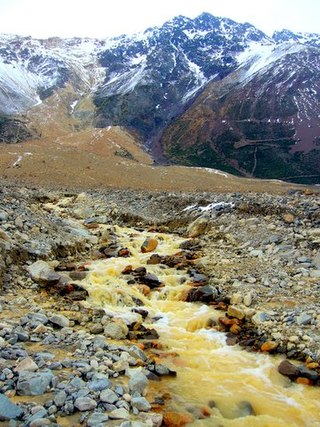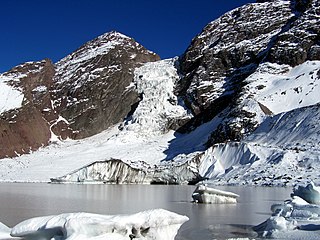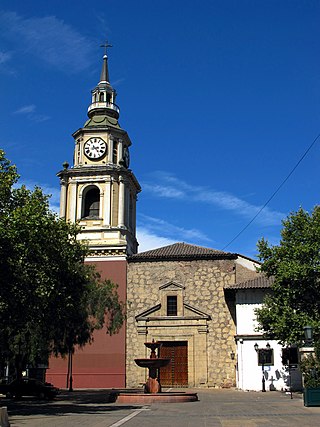
The San Francisco Glacier is a glacier in Monumento Natural El Morado Natural Park a hundred kilometers away from Santiago, Chile. It is a tourist attraction. [1]

The San Francisco Glacier is a glacier in Monumento Natural El Morado Natural Park a hundred kilometers away from Santiago, Chile. It is a tourist attraction. [1]
Olga Costa was a Mexican painter and cultural promoter. She began to study art at the Academy of San Carlos but left after only three months to help support her family. However, she met her husband, artist José Chávez Morado during this time. Her marriage to him involved her in Mexico's cultural and intellectual scene and she began to develop her ability to paint on her own, with encouragement from her husband. She had numerous exhibitions of her work in Mexico, with her work also sent to be sold in the United States. She was also involved in the founding and development of various galleries, cultural societies and three museums in the state of Guanajuato. She received the Premio Nacional de Ciencias y Artes among others for her work.

Cajón del Maipo is a canyon located in the Andean southeastern portion of the Santiago Metropolitan Region, Chile. It encompasses the upper Maipo River basin, where the river has entrenched itself in a narrow valley. The zone features a series of confluent rivers such as El Volcán River, Yeso River, and Colorado River, as well as other minor streams, including San Gabriel, Manzanito, Coyanco, El Sauce, El Manzano and San José. The main locality is San José de Maipo, the capital of the commune that includes all of the Andean sector of the Metropolitan Region. The valley ends close to Pirque and begins almost at the border with Argentina, where it is surrounded by some of the highest peaks in the region, including San José, Maipo, and Marmolejo, the most southerly mountain taller than 6,000 metres (20,000 ft) in the world. Several of the mountains are active volcanoes; San Jose was the most recent to erupt, in 1960.

El Morado Natural Monument is a Chilean Natural Monument located in the Cajón del Maipo, Santiago Metropolitan Region. The monument is a glacial cirque and is part of the El Volcán River basin. Cerro El Morado dominates the landscape of this protected area. It is home to the San Francisco Glacier.
Tlatlaya is one of 125 municipalities of the State of Mexico in Mexico. The municipal seat is the town of Tlatlaya which is the eleventh largest town in the municipality. The word “Tlatlaya” means when the hearth is black and red.

José Chávez Morado was a Mexican artist who was associated with the Mexican muralism movement of the 20th century. His generation followed that of Diego Rivera, José Clemente Orozco and David Alfaro Siqueiros. Although Chávez Morado took classes in California and Mexico, he is considered to be mostly self-taught. He experimented with various materials, and was an early user of Italian mosaic in monumental works. His major works include murals at the Ciudad Universitaria, Secretaría de Comunicaciones y Transportes and Museo Nacional de Antropología in Mexico City as well as frescos at the Alhóndiga de Granaditas, which took twelve years to paint. From the 1940s on, he also worked as a cultural promoter, establishing a number of cultural institutions especially in his home state of Guanajuato including the Museo de Arte Olga Costa - José Chávez Morado, named after himself and his wife, artist Olga Costa.

Cerro El Morado is a mountain in the Andes of Chile. It has a height of 4,674 metres (15,335 ft).
The Land Glacier is a broad, heavily crevassed glacier, about 35 nautical miles long, descending into Land Bay in Marie Byrd Land, Antarctica. It was discovered by the United States Antarctic Service (1939–41) and named for Rear Admiral Emory S. Land, Chairman of the United States Maritime Commission.
Bertram Glacier is a glacier, 15 nautical miles (28 km) long and 18 nautical miles (33 km) wide at its mouth, which flows west from the Dyer Plateau of Palmer Land into George VI Sound between Wade Point and Gurney Point.

Deportivo Saprissa is a Costa Rican sports club, mostly known for its football team. The club is based in San Juan de Tibás, San José, and play their home games at the Estadio Ricardo Saprissa Aymá. Their colours are burgundy and white. It is the main team representing the capital, but with the distinction of being massively followed throughout the whole country and overseas. The club was founded in 1935 and has competed in the Costa Rican first division since 1949. The name of the team comes from one of the club's main founders, Ricardo Saprissa Aymá. One of the most popular nicknames for the team El Monstruo Morado can be traced back to 1987, when the Costa Rican newspaper Diario Extra gave the team the nickname during a derby, because of the club's enormous following. A reporter commented that the sea of fans in the stands at the Estadio Ricardo Saprissa Aymá in Tibás wearing purple, and the tremendous noise they were generating, made him feel like he was "in the presence of a thousand headed monster". Saprissa immediately adopted the nickname El Monstruo Morado. It remains the most lauded football team in the whole region.
Paulus Glacier is a glacier west of Mount Cupola, flowing southeast from Rouen Mountains into Hampton Glacier, north Alexander Island, Antarctica. Photographed from the air by Ronne Antarctic Research Expedition (RARE), 1947–48, and mapped from the air photographs by D. Searle of Falkland Islands Dependencies Survey (FIDS), 1960. Named by Advisory Committee on Antarctic Names (US-ACAN) after Lieutenant Commander John F. Paulus, U.S. Navy, LC-130 aircraft commander, Squadron VXE-6, U.S. Navy Operation Deepfreeze, 1969 and 1970.
Meiklejohn Glacier is a glacier, 12 nautical miles (22 km) long and 4 nautical miles (7 km) wide, flowing southwest from the Dyer Plateau of Palmer Land, Antarctica, to George VI Sound, immediately south of Moore Point. In its lower reaches the south side of this glacier merges with Millett Glacier. It was first surveyed in 1936 by the British Graham Land Expedition (BGLE) under John Rymill, and was named by the UK Antarctic Place-Names Committee in 1954 for Ian F. Meiklejohn, a radio operator of the BGLE.

The Apoquindo Waterfall is a waterfall in Waters of Ramon Natural Park on the east side of Santiago, Chile, near Apoquindo. It is fed by melting snow from Cerro de Ramon and Cerro Provincia. The waterfall has a main drop of about 25 meters (82 ft).

The Southern Andean steppe is a montane grasslands and shrublands ecoregion occurring along the border of Chile and Argentina in the high elevations of the southern Andes mountain range.

Apoquindo is the name of a river and pre-Columbian settlement located east of the city of Santiago de Chile, at the foot of the foothills, in the present town of Las Condes. This settlement later became known as the Pueblo de Indios in place names Apoquindo and transferred to an estate, the Mount Apoquindo, the Apoquindo Waterfall, the Apoquindo Avenue, to the district San Carlos de Apoquindo, the Apoquindo College and other geographical landmarks and urban community.

The San Francisco Church is a Franciscan church on Avenida Libertador General Bernardo O'Higgins, in the downtown of Santiago de Chile. The church, along with the adjacent convent, is one of the oldest colonial-era buildings in the country. It has been resistant to about 15 earthquakes of magnitude over 7.

Santa Rosa station is an embanked metro station located on Line 4A of the Santiago Metro in Santiago, Chile, between the La Granja and San Ramón stations and also between the communes of the same names La Granja and San Ramón. It lies along the Vespucio Sur Freeway, on its junction with Santa Rosa Avenue. The station was opened on 16 August 2006 as part of the inaugural section of the line between Vicuña Mackenna and La Cisterna.

The Purple Party is a centrist, liberal and progressive Peruvian political party. The color purple was chosen to represent the blending of red and blue, the colors of left and right-wing parties in Peru, symbolizing the centrist ideology of the party.
33°46′14.59″S70°04′16.09″W / 33.7707194°S 70.0711361°W